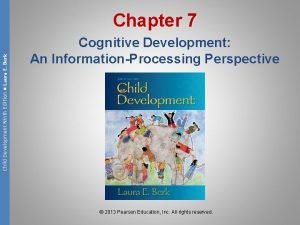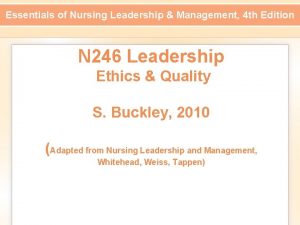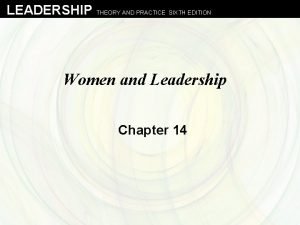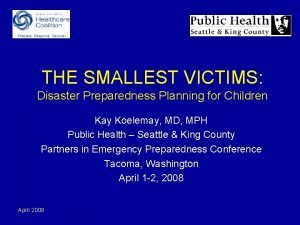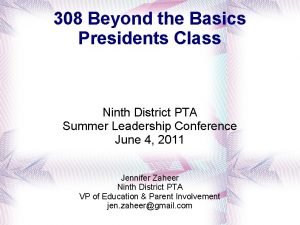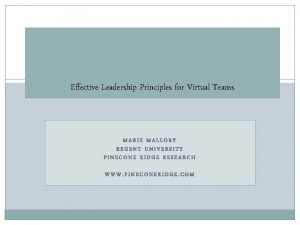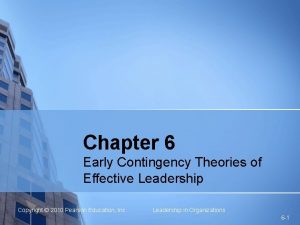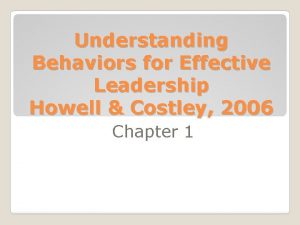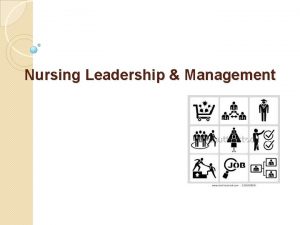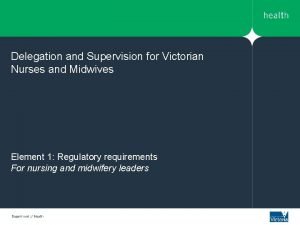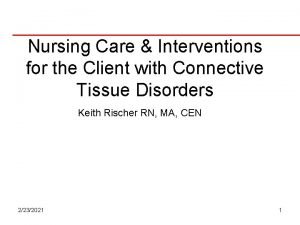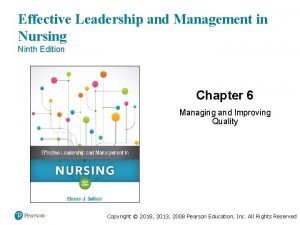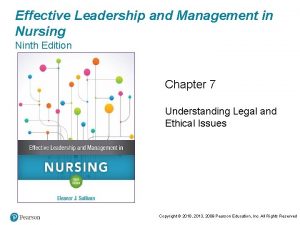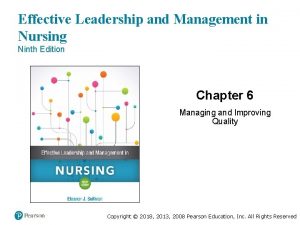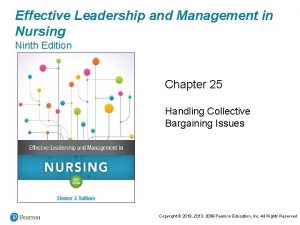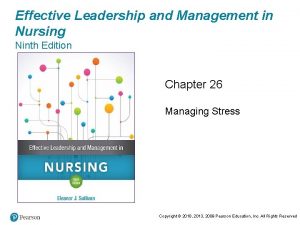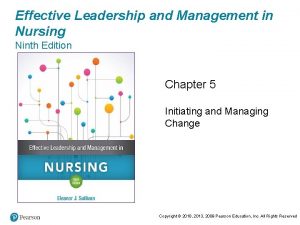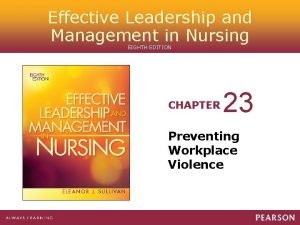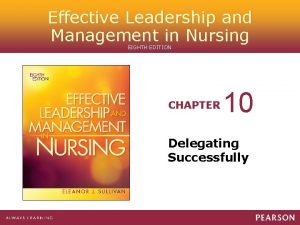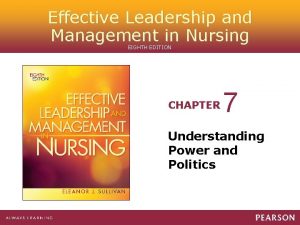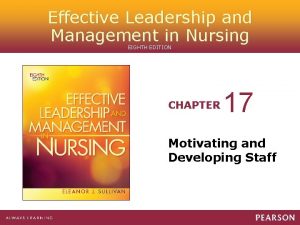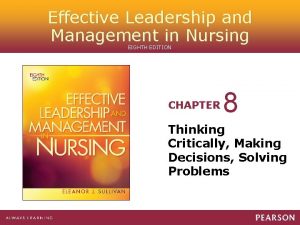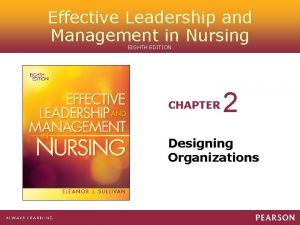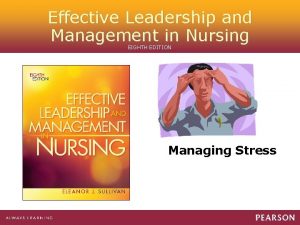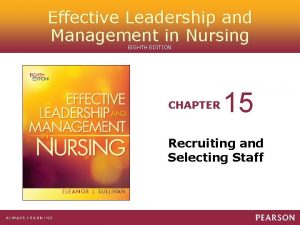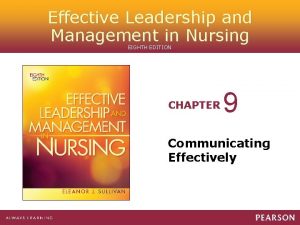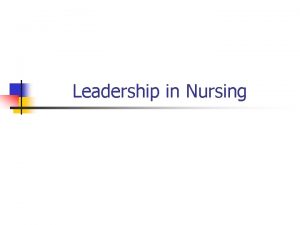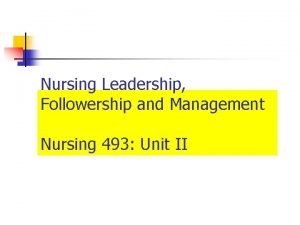Effective Leadership and Management in Nursing Ninth Edition











































- Slides: 43

Effective Leadership and Management in Nursing Ninth Edition Chapter 8 Understanding Power and Politics Copyright © 2018, 2013, 2008 Pearson Education, Inc. All Rights Reserved

Learning Outcomes 8. 1 Differentiate between power and leadership. 8. 2 Describe how to use power appropriately. 8. 3 Explain how to use shared visioning as a power tool. 8. 4 Explore the relationships among power, politics, and policy. 8. 5 Summarize ways nurses can influence nursing’s future. Copyright © 2018, 2013, 2008 Pearson Education, Inc. All Rights Reserved

Key Terms (1 of 3) • Coercive power • Connection power • Expert power • Information power • Legitimate power Copyright © 2018, 2013, 2008 Pearson Education, Inc. All Rights Reserved

Key Terms (2 of 3) • Personal power • Policy • Politics • Position power • Power Copyright © 2018, 2013, 2008 Pearson Education, Inc. All Rights Reserved

Key Terms (3 of 3) • Power plays • Referent power • Reward power • Shared visioning • Stakeholders • Vision Copyright © 2018, 2013, 2008 Pearson Education, Inc. All Rights Reserved

Introduction • Power is the potential ability to influence others • Symmetrical power – Two parties have equal and reciprocal power. • Asymmetrical power – One person or group has more control than another. • Power can be exclusive to one party or may be shared among many people or groups. Copyright © 2018, 2013, 2008 Pearson Education, Inc. All Rights Reserved

Learning Outcome 8. 1 Differentiate between power and leadership. Copyright © 2018, 2013, 2008 Pearson Education, Inc. All Rights Reserved

Power and Leadership (1 of 7) • Principle-centered power – Based on honor, respect, loyalty, and commitment – Model congruent with nursing’s values • Power sharing flows from values and principles • Leadership power – Comes from the ability to sustain proactive influence. Copyright © 2018, 2013, 2008 Pearson Education, Inc. All Rights Reserved

Power and Leadership (2 of 7) • Nurses must understand select behaviors that activate principle-centered leadership – Get to know people. – Be open. – Know your values and visions. – Sharpen your interpersonal competence. – Use your power to enable others. – Enlarge your sphere of influence and connectedness. Copyright © 2018, 2013, 2008 Pearson Education, Inc. All Rights Reserved

Power and Leadership (3 of 7) • Power: How Managers and Leaders Get Things Done – Leader’s use of power alters attitudes and behavior by addressing individual needs and motivations. – Seven generally accepted types of interpersonal power used in organizations to influence others: 1. Reward – Based on the inducements the manager can offer in exchange for cooperation and contributions Copyright © 2018, 2013, 2008 Pearson Education, Inc. All Rights Reserved

Power and Leadership (4 of 7) 2. Coercive – Based on the penalties a manager might impose on an individual or a group 3. Legitimate – Stems from manager’s right to make a request because of authority associated with job and rank 4. Expert – Based on possession of unique skills, knowledge, and competence Copyright © 2018, 2013, 2008 Pearson Education, Inc. All Rights Reserved

Power and Leadership (5 of 7) 5. Referent – Based on admiration and respect 6. Information – Based on access to valued data 7. Connection – Based on an individual’s formal and informal links to influential or prestigious persons inside and outside an area or organization Copyright © 2018, 2013, 2008 Pearson Education, Inc. All Rights Reserved

Power and Leadership (6 of 7) • Position power – Determined by: ▪ Job description ▪ Assigned responsibilities ▪ Recognition ▪ Advancement ▪ Authority ▪ Ability to withhold money ▪ Decision making – Legitimate, coercive, and reward power are positional. Copyright © 2018, 2013, 2008 Pearson Education, Inc. All Rights Reserved

Power and Leadership (7 of 7) • Personal Power – Refers to: ▪ Credibility ▪ Reputation ▪ Expertise ▪ Experience ▪ Control of resources or information ▪ Ability to build trust – Expert, referent, information, and connection power are based, for the most part, on personal traits. Copyright © 2018, 2013, 2008 Pearson Education, Inc. All Rights Reserved

Learning Outcome 8. 2 Describe how to use power appropriately. Copyright © 2018, 2013, 2008 Pearson Education, Inc. All Rights Reserved

Using Power (1 of 11) • Some nurses still consider power unattractive. • Negative association of power with aggression and coercion remains strong – Power grabbing ▪ Traditionally accepted means of relating to power for one’s own self-interests and use • Nurses tend to be more comfortable with power sharing and empowerment. Copyright © 2018, 2013, 2008 Pearson Education, Inc. All Rights Reserved

Using Power (2 of 11) • Image as Power – A powerful image enhances the ability to achieve goals. – Images emerge from interactions and communications with others. – Positive interactions create a strong, favorable image for the individual and the profession. Copyright © 2018, 2013, 2008 Pearson Education, Inc. All Rights Reserved

Using Power (3 of 11) – Individual nurses can promote an image of power by a variety of means. 1. Introduce yourself by saying your name, using eye contact, and shaking hands. 2. Dress appropriately. – Attire can symbolize power and success. 3. Convey a positive and energetic attitude. 4. Pay attention to how you speak and how you act when you speak. – Nonverbal signs and signals say more about you than words. Copyright © 2018, 2013, 2008 Pearson Education, Inc. All Rights Reserved

Using Power (4 of 11) 5. Use facts and figures when you need to demonstrate your point. – Patient acuity, daily census, length of stay, and overtime budgets – Data that reflect nursing's overall contribution 6. Become visible, be available, and offer assistance. – Knowing when to be at the right place at the right time is crucial for gaining access to key personnel in the organization. Copyright © 2018, 2013, 2008 Pearson Education, Inc. All Rights Reserved

Using Power (5 of 11) 7. When dealing with people outside of nursing, it is important to develop powerful partnerships. 8. Make it a point to get to know the people who matter in your sphere of influence. – The more power you use, the more you get. – Know who holds the power. – Identify key power brokers. – Develop a strategy for gaining access to power brokers. – Develop a keen sense of timing. Copyright © 2018, 2013, 2008 Pearson Education, Inc. All Rights Reserved

Using Power (6 of 11) 9. Powerful people have a keen sense of timing. – Be sure to position yourself to be at the right place at the right time. 10. Use power appropriately to promote consensus in organizational goals. – By capitalizing on the special relationship that nurses have with patients, they can enhance their position and image as professional caregivers. Copyright © 2018, 2013, 2008 Pearson Education, Inc. All Rights Reserved

Using Power (7 of 11) – Nursing’s goal is to ensure that identified markets have a clear understanding of what nursing is. ▪ Nursing is seen as a profession that gives expert care with a scientific knowledge base. – Nursing care is often seen as an indicator of an organization’s overall quality. Copyright © 2018, 2013, 2008 Pearson Education, Inc. All Rights Reserved

Using Power (8 of 11) • Using Power Appropriately – The way power is used has a lasting effect on relationships. ▪ Best to use least amount of power necessary. – Use power appropriate to the situation. ▪ Improper use of power can destroy a manager’s effectiveness. – Power can be overused or underused. ▪ Power plays – Attempts to diminish or demolish one’s opponents. Copyright © 2018, 2013, 2008 Pearson Education, Inc. All Rights Reserved

Using Power (9 of 11) – Nursing must perceive power for what it really is. ▪ The ability to mobilize and focus energy and resources – Power is the means, not the end, to seek new ways of doing things in this uncertain and unsettling time in healthcare. Copyright © 2018, 2013, 2008 Pearson Education, Inc. All Rights Reserved

Using Power (10 of 11) • Rules for Using Power 1. Use the least amount of power you can to be effective in your interactions with others. 2. Use power appropriate to the situation. 3. Learn when not to use power. 4. Focus on the problem, not the person. Copyright © 2018, 2013, 2008 Pearson Education, Inc. All Rights Reserved

Using Power (11 of 11) 5. Make polite requests, never arrogant demands. 6. Use coercion only when other methods do not work. 7. Keep informed to retain your credibility when using your expert power. 8. Understand you may owe a return favor when you use your connection power. Copyright © 2018, 2013, 2008 Pearson Education, Inc. All Rights Reserved

Learning Outcome 8. 3 Explain how to use shared visioning as a power tool. Copyright © 2018, 2013, 2008 Pearson Education, Inc. All Rights Reserved

Shared Visioning as a Power Tool (1 of 3) • Shared visioning – Interactive process in which leaders and followers commit to the organization's goals • Vision – Mental model of a possible future Copyright © 2018, 2013, 2008 Pearson Education, Inc. All Rights Reserved

Shared Visioning as a Power Tool (2 of 3) • A shared vision of an organization achieves the following: – Drives the organization’s future – Determines future goals – Makes implementing the necessary, and often difficult, changes easier – Provides a benchmark to evaluate future projects – Encourages both administrators and staff to accomplish goals – Inspires and challenges both leaders and followers Copyright © 2018, 2013, 2008 Pearson Education, Inc. All Rights Reserved

Shared Visioning as a Power Tool (3 of 3) • Integrated leadership styles essential to success • Innovation necessary to effect positive change • Leader helps guide group toward desired vision Copyright © 2018, 2013, 2008 Pearson Education, Inc. All Rights Reserved

Learning Outcome 8. 4 Explore the relationships among power, politics, and policy. Copyright © 2018, 2013, 2008 Pearson Education, Inc. All Rights Reserved

Power, Politics, and Policy (1 of 8) • Politics – The art of influencing others to achieve a goal – Encompasses the following: ▪ Is an interpersonal endeavor ▪ Is a collective activity ▪ Requires analysis and planning ▪ Involves image Copyright © 2018, 2013, 2008 Pearson Education, Inc. All Rights Reserved

Power, Politics, and Policy (2 of 8) • Nursing's Political History – Political activities ▪ Began with Florence Nightingale ▪ Continued with nursing schools and women's suffrage ▪ Improved with establishment of nursing organizations ▪ Feminism movement – Policy ▪ The decision that determines action ▪ Policies result from political action. Copyright © 2018, 2013, 2008 Pearson Education, Inc. All Rights Reserved

Power, Politics, and Policy (3 of 8) • Using Political Skills to Influence Policies – Political skill is a vital skill for nurses to acquire. – Adhere to the following to improve your political skill: ▪ Learn self-promotion. – Report your accomplishments appropriately. ▪ Be honest and tell the truth. – Say what you mean and mean what you say. ▪ Use compliments. – Recognize others’ accomplishments. Copyright © 2018, 2013, 2008 Pearson Education, Inc. All Rights Reserved

Power, Politics, and Policy (4 of 8) – Adhere to the following to improve your political skill: ▪ Discourage gossip – Silence is the best response. ▪ Learn and use quid pro quo. – Do and ask for favors. ▪ Remember: Appearance matters. – Attend to grooming and attire. ▪ Use good manners. – Be courteous. Copyright © 2018, 2013, 2008 Pearson Education, Inc. All Rights Reserved

Power, Politics, and Policy (5 of 8) – Identify the stakeholders ▪ People or groups who have a direct interest in the work of an organization ▪ Piggyback on their ideas. – Political action in the community ▪ Start telling supporters about the idea. – See if they will join with you in a coalition. Copyright © 2018, 2013, 2008 Pearson Education, Inc. All Rights Reserved

Power, Politics, and Policy (6 of 8) • Steps in Political Action 1. Determine what you want. 2. Learn about the players and what they want. 3. Gather supporters and form coalitions. 4. Be prepared to answer opponents. 5. Explain how what you want can help them. Copyright © 2018, 2013, 2008 Pearson Education, Inc. All Rights Reserved

Power, Politics, and Policy (7 of 8) • Influencing Public Policies – Workplace depends upon and influences what is happening in the larger community, professional organizations, and government all interact. ▪ Developing influence in each of these three groups takes time and a long-range plan of action. ▪ Be respectful. ▪ Learn how to communicate with elected officials. ▪ Be prepared to meet with elected officials. Copyright © 2018, 2013, 2008 Pearson Education, Inc. All Rights Reserved

Power, Politics, and Policy (8 of 8) • How to Work with Public Officials 1. Be respectful. 2. Build relationships. 3. Keep in touch. 4. Arrive informed. 5. Understand the issue. 6. Be a constructive opponent. 7. Be realistic. 8. Be helpful. Copyright © 2018, 2013, 2008 Pearson Education, Inc. All Rights Reserved

Learning Outcome 8. 5 Summarize ways nurses can influence nursing’s future. Copyright © 2018, 2013, 2008 Pearson Education, Inc. All Rights Reserved

How Nurses Can Influence the Future (1 of 2) • Convert policy ideas into political realities using the following power points: – Use persuasion over coercion. ▪ Persuasion is the ability to share reasons and rationale when making a strong case for your position while maintaining a genuine respect for another’s perspective. – Use patience over impatience. ▪ Impatience in the nursing community can be detrimental. Copyright © 2018, 2013, 2008 Pearson Education, Inc. All Rights Reserved

How Nurses Can Influence the Future (2 of 2) • Convert policy ideas into political realities using the following power points: – Be open-minded rather than closed-minded. – Use compassion over confrontation. ▪ It takes genuine care and concern to change course and make corrections. – Use integrity over dishonesty. ▪ Control, manipulation, and malice must be pushed aside for change to occur. Copyright © 2018, 2013, 2008 Pearson Education, Inc. All Rights Reserved

Copyright © 2018, 2013, 2008 Pearson Education, Inc. All Rights Reserved
 Anatomy and physiology ninth edition
Anatomy and physiology ninth edition Levels of analysis psychology
Levels of analysis psychology Mankiw macroeconomics 9th edition
Mankiw macroeconomics 9th edition General adaptation syndrome
General adaptation syndrome Social psychology ninth edition
Social psychology ninth edition Biology ninth edition
Biology ninth edition Child development ninth edition
Child development ninth edition Child development ninth edition
Child development ninth edition Abnormal psychology ronald j comer 9th edition
Abnormal psychology ronald j comer 9th edition Psychology ninth edition in modules
Psychology ninth edition in modules David myers psychology 9th edition
David myers psychology 9th edition Biology ninth edition
Biology ninth edition Campbell ninth edition
Campbell ninth edition Classify and explain importance of values in nursing
Classify and explain importance of values in nursing 6th and 9th commandment are related
6th and 9th commandment are related The sixth and ninth commandments
The sixth and ninth commandments Leadership theory and practice 6th edition
Leadership theory and practice 6th edition Phos root word examples
Phos root word examples Whatvis ramadan
Whatvis ramadan William blount ninth grade academy
William blount ninth grade academy Lower ninth ward
Lower ninth ward French classical menu in english
French classical menu in english Ninth district pta
Ninth district pta Using mis 10th edition
Using mis 10th edition Mis
Mis Transactional vs transformational leadership
Transactional vs transformational leadership Care plan on cataract
Care plan on cataract Principles of effective leadership in virtual teams
Principles of effective leadership in virtual teams Early contingency theories of effective leadership
Early contingency theories of effective leadership Understanding behaviors for effective leadership
Understanding behaviors for effective leadership Sharpen the saw examples
Sharpen the saw examples Nursing leadership theories and styles
Nursing leadership theories and styles Leadership and delegation in nursing
Leadership and delegation in nursing Adaptive leadership theory
Adaptive leadership theory Enthusiastic beginner disillusioned learner
Enthusiastic beginner disillusioned learner 5 levels of prevention leavell and clark
5 levels of prevention leavell and clark Staffing and nursing care delivery models
Staffing and nursing care delivery models Accountability vs responsibility in nursing
Accountability vs responsibility in nursing Ocronic
Ocronic Food and beverage management book free download
Food and beverage management book free download Food service cycle
Food service cycle Smooth running
Smooth running Masterclassmanagement
Masterclassmanagement Leadership definition
Leadership definition






